Description of tomatoes of the "Pineapple" variety: features of their cultivation in open and closed ground
Pineapple tomato varieties in Russia began to be grown relatively recently, and despite this, it has already become very popular among summer residents. Reviews about this variety are the most positive.
The delight is explained by the fact that Pineapple tomatoes not only have a pleasant taste, but also long-term fruiting. How to grow this tomato, what are its distinctive features and productivity, you will learn from our article.
The content of the article
- Description of the variety
- How to grow seedlings?
- How to grow tomatoes
- Features of cultivation and possible difficulties
- The nuances of cultivation in the open field and in the greenhouse
- Harvesting and application of the crop
- Advantages and disadvantages of the variety
- Varieties of Black, Gold, Hawaiian and Beefsteak
- Photo
- Farmers reviews
- Related Videos
Description of the variety
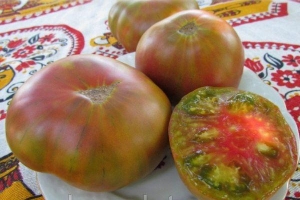 Tomato Pineapple - resistant to diseases and unpretentious care. It belongs to tall varieties, the height of the bush reaches 2 m during the growing season.
Tomato Pineapple - resistant to diseases and unpretentious care. It belongs to tall varieties, the height of the bush reaches 2 m during the growing season.
It is recommended to form the variety into 3 stems. The first inflorescences appear on bushes near 8-9 leaves. From 5 to 6 fruits ripen on one brush.
Tomato varieties Pineapple is of several types:
- Taiwanese.
- Yellow.
- Hawaiian.
- BIO.
- Steak.
- Black etc.
Distinctive features
The varieties differ in the color of the fruit. Many of them have not only pleasant taste, but also an unusual color. For example, Black Pineapple is brown with green stripes, but the flesh of a tomato is completely green.
But the variety Pineapple beefsteak is bright orange, and in the cut from orange to the edges it turns yellow. Another difference between Pineapple and other varieties is the high sugar content in fruits, tomatoes have citrus notes.
Fruit characteristics and yield
 The fruits of the Pineapple variety are large enough, the weight of one reaches 900 g, the average weight is about 250 g. The tomatoes are sweetish with citrus taste and fruity notes.
The fruits of the Pineapple variety are large enough, the weight of one reaches 900 g, the average weight is about 250 g. The tomatoes are sweetish with citrus taste and fruity notes.
By the end of the harvest season, the taste of tomato becomes even richer. The fruit has firm flesh and few seed chambers. Vegetables are strong, do not crack, they perfectly tolerate transportation over long distances without losing their presentation.
Up to 40 brushes grow on one bush, each with about 5-6 fruits. With an average weight for the fruiting period, the bush gives at least 30 kg. If the growth is artificially stopped, then it is possible to increase the yield without losing taste.
How to grow seedlings?
Tomatoes are delicious and beloved by many. They come in different sizes, large and small, fleshy and juicy. And most importantly, they are easy to grow.
To grow seedlings you need:
- Prepare the seeds.
- Select a container and prepare the soil.
- Sow a change.
- Grow seedlings.
- Provide her with proper care.
Let's consider each of the points separately.
Seed preparation
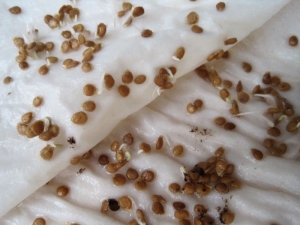 So that your efforts when planting seeds are not in vain, they must be carefully sorted out. To speed up the screening process, place them in a container of salt water.
So that your efforts when planting seeds are not in vain, they must be carefully sorted out. To speed up the screening process, place them in a container of salt water.
The water is diluted as follows: 1 tablespoon in a glass of water. After 10 minutes, bad seeds will float, and suitable ones will fall to the bottom.
After selecting seeds, they need to be prepared for planting.:
- Disinfection protect the plant from diseases. For this:
- The seeds should be left in a 0.8% vinegar solution or for a third of an hour in a weak manganese solution.
- After the procedure, gently rinse the seeds with running water and dry.
- Warming up the seeds done if they have been in a cold place for a long time.Warm them up as follows:
- Or they leave it near the battery for 2-3 days.
- Or for a few hours in a thermos with hot water. Then they are dried.
- Hardening helps young sprouts to adapt to different environmental conditions.
- Take a piece of cloth, put the seeds on one half, and cover the other on top, put on a saucer, pour in some water and leave in the room for one day.
- On the second day, remove the plate with seeds on the bottom shelf of the refrigerator for 24 hours.
- Repeat the procedure a day later.
All these procedures are needed to prepare the future plant for various environmental changes and improve yields.
Attention! After the seeds are prepared, they must be planted immediately. That is why, while the seed is being prepared, prepare the planting site.
Capacity and soil
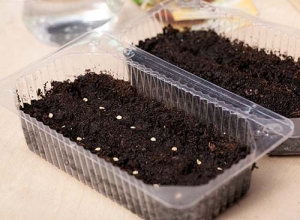 Before planting seeds, you need to prepare the soil and container for planting. Choose a large container to plant all the seeds at once.
Before planting seeds, you need to prepare the soil and container for planting. Choose a large container to plant all the seeds at once.
When the tomatoes sprout, they are already seated in separate cups.
The soil for planting tomatoes should consist of three frequent:
- turf;
- humus;
- sand.
If for some reason you do not have the opportunity to prepare the mixture yourself, then it can be purchased at a specialized store. Seeds are planted 1.5-2 months before transplanting seedlings to a garden bed or greenhouse.
If you do this ahead of time, then the sprouts will not have time to get stronger and will die. And if you delay with this process, then they will stretch out and it will be inconvenient to transplant.
Sowing:
- Pour the soil mixture into the prepared container and tamp it slightly.
- Water the finished soil and cover with foil overnight.
- The next day, the soil must be leveled and sowing grooves made at a distance of about 4 cm from each other, the depth of the hole is 1 cm.
- Pour the seeds evenly into the finished holes, sprinkle them with earth and water.
- Cover the container with foil and put it on the window.
- After a week, the film must be removed and the container must be moved to a room where the temperature is up to +16 degrees.
- After another week, the container with the seedlings must be returned to the windowsill and the sprouts must be provided with a temperature regime during the day up to +24, at night up to +12 degrees.
Cultivation and care
 The main thing in tomato care is to properly provide and maintain certain environmental factors at the right level. Such as the:
The main thing in tomato care is to properly provide and maintain certain environmental factors at the right level. Such as the:
- humidity;
- temperature;
- Fresh air;
- lighting.
Let's look at all the factors and prerequisites in more detail.:
- Watering... Until the seeds have sprouted first, soil moisture must be checked every day. If the soil is dry, dampen it with a spray bottle.
Important! In no case do not water the soil with seeds without a special device, otherwise you can wash the seeds out of the soil.
Water with warm water, a second watering in a week. But monitor soil moisture every day. If it dries up, the sprout will die. The plant is watered with a pipette at the root, without falling on the leaves.
- Lighting... For seedlings, choose the lightest spot in the room. Most often this is a windowsill. In addition to natural light, the plant will also need artificial light, which can be organized using a lamp. The plant should be illuminated for at least 14 hours a day.
- Temperature... In order for the sprouts to sprout, the temperature in the room must be from +25 to +28 degrees. After a week, the temperature can be lowered to + 20-25 degrees. And two weeks later - to the room.
- Airing and humidity... While the seeds are under the film, the container should be lifted and moisture removed so that mold does not appear due to excess moisture. If mold does appear, remove the affected soil and water the soil with a solution of potassium permanganate. The film can be removed only after 1-2 weeks after seedlings. So that this is not an injury for the plant, the film needs to be opened for a short time every day.
- Fertilizer... After the first shoots have appeared, at least 10-14 days should pass before the first feeding. After that, the plant is fertilized every week. Fertilizers are introduced when the sprouts produce the first leaves with cloves. After the sprouts of tomatoes give the first true leaves, they must be dived.
reference! A picking is the procedure for transplanting a plant from a common container into an individual pot or glass no less than 10x10 in size.
In the process of picking, all sick and weak plants are eliminated. When picking, the seedlings are transplanted deeply, the stem is buried to the very leaves.
How to grow tomatoes
Before planting seedlings in a garden or greenhouse, it must be hardened... To do this, it is enough to leave the vents open at night.
Landing
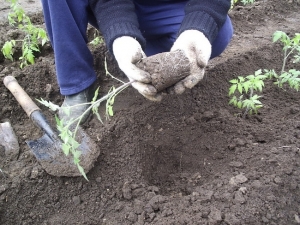 Tomatoes are planted in open ground at the end of May at the beginning of June, when they are no longer threatened with frost. By this time, the plant already has a strong stem and at least 5 leaves.
Tomatoes are planted in open ground at the end of May at the beginning of June, when they are no longer threatened with frost. By this time, the plant already has a strong stem and at least 5 leaves.
Before transplanting tomatoes, you need to prepare the soil.:
- Rake the land.
- Make holes at a distance of 30 cm.
- Fertilize each well with 1 tablespoon of superphosphate.
- Pour water over each hole.
When the soil is ready for replanting, it is necessary:
- Stick a peg next to each hole, which will become a support for the bush.
- Before planting, the hole is watered again and the sprout is planted along with the earth from the cup.
- Next, the plant is lightly tamped with earth and watered.
Care
After the plant has been transplanted to a garden bed or greenhouse, it must be looked after as carefully as the seedlings on the windowsill.
Basic procedures:
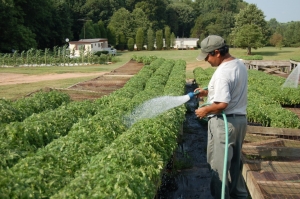
- Loosening... At the first time after transplanting the plant, it is imperative to monitor the condition of the soil and prevent cracking. When the plant takes root and gets stronger, the soil can be loosened every 4 days.
- Watering... When watering, water should not come into contact with the plant. While the tomato bush is growing, the frequency of watering is increased, when the first fruits appear, they are reduced. Tomatoes are watered with relatively warm water, cold water can chill the roots, leading to the death of the plant.
- Top dressing... After two weeks after transplanting, the tomato must be fed with a mixture of: saltpeter, urea, superphosphate and potassium salt. After three weeks, the procedure is repeated.
- Weeding carried out every 14 days in parallel with loosening. You need to weed the bed manually. Removing weeds promotes good plant growth and yield.
- Plant grazing - one of the important activities that must be carried out at all stages of development. Grasshopping is the removal of lateral shoots from a plant. It is performed using a secateurs or manually. It is advisable to do this before the shoot grows to 5 cm, then it will injure your plant less. Before you start removing unwanted shoots, decide how many stems you want to grow the bush. If 2-3, then the growth of young shoots must be stopped in time.
- Bush formation... One of the main questions when growing a pineapple variety: how many stems to grow. Tall varieties, which include tomato Pineapple, lead to one stem. To do this, we form a bush using the pinching method already known to us. When choosing a method for forming a bush, also do not forget about such an important factor as climatic conditions.
- Garter tomatoes - a mandatory event. Pineapple belongs to tall varieties, has delicate and weak stems that can break under their own weight or under the weight of ripening varieties. A tied plant is easier to water and loosen. And the garter of a tomato protects its fruits from pests and various diseases.
With proper care, the plant will delight you not only with stable growth and development, but with excellent yield.
Features of cultivation and possible difficulties
 Tomato Pineapple is a mid-season variety: in order to get an earlier harvest, the seeds must be planted at the end of March at the beginning of April.
Tomato Pineapple is a mid-season variety: in order to get an earlier harvest, the seeds must be planted at the end of March at the beginning of April.
7 days before planting a tomato Pineapple, you need to start hardening the plant... To do this, they are taken out into the fresh air. Every day, the time spent in the open air is increased, for 3-4 days they are left in the air overnight.
Attention! Avoid direct sunlight on the leaves, otherwise they may be burned.
When planting a tomato in open ground, do not forget that the plant is tall and there should not be more than 2-3 bushes on one square meter.
Watering tomatoes should be done carefully and in moderation, otherwise the soil may not only develop a fungus, but the roots will also begin to rot. The plants are fed every two weeks. If you take proper care of the tomato, they will delight you with a bountiful harvest until the fall.
Difficulties in growing tomatoes can be very diverse:
- Seedlings that grow on the windowsill, in favorable conditions, become pampered and, when transplanted, it will not be easy for them to adapt. To avoid this, temper the seedlings.
- The leaves of the seedlings turn yellow and dry - these are the consequences of a lack of light or an excess of moisture.
- Plants do not have enough light due to planting pieces too close, and they begin to stretch towards the light.
- If the leaves are limp and saggy, the plant lacks moisture.
- If white spots appear on tomato leaves, then they received a sunburn, but brown spots signal a fungal disease.
To overcome all these difficulties, it is enough to carefully examine the plants and follow the basic rules for caring for them.
Diseases and pests
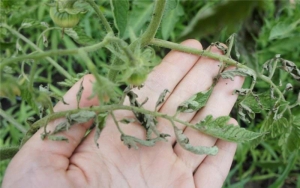 Diseases and pests affect growth and yield... There are several problems that can be identified by their appearance. All diseases, except fungal, can be prevented or cured by feeding the plant with this or that fertilizer.
Diseases and pests affect growth and yield... There are several problems that can be identified by their appearance. All diseases, except fungal, can be prevented or cured by feeding the plant with this or that fertilizer.
But the spread of mold on the plant threatens you with the loss of the entire bush and contamination of the neighboring ones. This is because the fungus spreads rapidly.
But there are several more dangerous diseases and pests that you need to know about.:
- Blooming rot on the back of the fruit... It is easy to recognize it: on the back of the fruit there is a dark spot the size of a two-ruble coin. You can get rid of the disease by removing the affected fruits. To avoid a second disease, you need to monitor watering and fertilize the plant with calcium (some gardeners use crushed eggshells as top dressing).
- Flowers are tied but fall off and the fetus either does not have time to develop at all, or is very poorly developed. This often happens due to sudden changes in the weather, for example: during the day the temperature was above 35 degrees, and at night it dropped to 10. Mulching will help to avoid the problem.
- Sticky and misshapen leaves... The reason is the pear-shaped aphid. It damages the plant by sucking the juice out of it and leaving behind a sticky substance on the leaves and fruits. In addition to aphids, whiteflies and spider mites can cause the same visible symptoms. Special insecticidal sprays and removal of weeds around the plant will help get rid of pests.
- Fruit skin cracking... Cracks can appear due to accelerated growth caused by high humidity, for example: after a long drought it has rained. Another reason may be the banal overripening of the fetus.
- Formation of black-brown spots on the leaves... The cause of these symptoms is a fungus that survived on old plants and passed on to new ones. To cure the plant, you will need to purchase special aerosols and remove any old plants from your garden.
- Nematodes... The bad news is that the plant cannot be cured of this scourge. Good - despite this, the plant is capable of producing edible fruits.To prevent new plants from getting sick, plant marigolds next to the garden bed, they release chemicals that kill nematodes.
Attention! In no case should such plants be left in the garden or put into a compost pit. Otherwise, contamination of healthy plants cannot be avoided. It is best to burn old plants or remove them from the site.
The nuances of cultivation in the open field and in the greenhouse
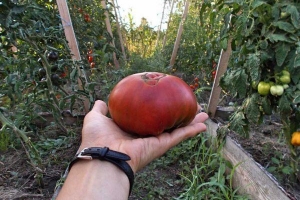 When growing any plant, there are certain nuances that must be taken into account.
When growing any plant, there are certain nuances that must be taken into account.
The nuances of growing tomato Pineapple in the open field and in the greenhouse:
- Wrong choice of landing site... Choose a sunny area where nightshades have not previously been planted.
- Growing different crops together... For example: cucumbers and tomatoes cannot be planted in the same greenhouse, since they need completely different climatic conditions.
- Incorrect formation of tomatoes... Sometimes gardeners feel sorry for removing side shoots, or they forget to pinch the top in time. The bush grows lush and weighty, but, unfortunately, does not bear fruit. A plant that was planted in open ground should not have more than 4 stems.
- Stalk... When tying tomatoes, you need to be extremely careful not to damage the stem.
- Late pinching... If the side shoots are not removed in time, the yield will suffer. They need to be removed at a size of 3-4 cm, since they consume all nutrients and prevent the plant from developing.
- Eating disorder... Sometimes gardeners are fond of feeding the plant and instead of a large harvest they get a lush bush with large strong leaves. This is due to the large amount of manure.
- Closed greenhouse... If the greenhouse has high humidity and temperature, you should not close it. In tomatoes, pollen grains stick together and there is no normal pollination, respectively, the plant bears worse fruit.
- Untimely processing... Greenhouse tomatoes should be biologically treated every two weeks or after each harvest.
Harvesting and application of the crop
Pineapple tomatoes are harvested after the fruits are fully ripe. The plant belongs to mid-ripening varieties, therefore, the risk of unripe fruit before the end of the growing season is minimized.
Tomato varieties Pineapple are consumed:
- fresh;
- in salads;
- first and second courses.
Tomatoes are also well suited for canning whole fruits.
Advantages and disadvantages of the variety
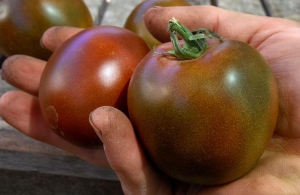 The variety got its name not only because of its appearance, but also for its taste.
The variety got its name not only because of its appearance, but also for its taste.
The main benefits of tomato include:
- the appearance and taste of a tomato resembles pineapple and citrus;
- suitable for consumption both fresh and for winter preparations;
- high yield rates;
- easy care.
The main disadvantage of the variety is its frequent pinching, which will take more time when caring for the plant. There is also a small minus - large fruits must be eaten immediately, they are not suitable for pickling.
Varieties of Black, Gold, Hawaiian and Beefsteak
Pineapple tomatoes have several varieties:
- Black pineapple originally from Belgium. The fruit is colored in three colors: yellow, burgundy and orange. Despite its excellent taste, it is not suitable for preparations for the winter. The weight of one reaches 700 g.
- Golden pineapple has a gold color with a pink cap. It also has excellent taste. Suitable for eating raw and for preforms. Fruit weight 200-600 g.
- Hawaiian pineapple has an orange color, the fruits are large, the weight of one can reach 700 g.
- Tomato Beefsteak Pineapple, one fruit weighs about 300 g. It has a bright red color.
All of them are approximately similar in their taste, are resistant to diseases and pests.
Photo
Next you can see a photo of the varieties of Pineapple tomatoes.
The black:
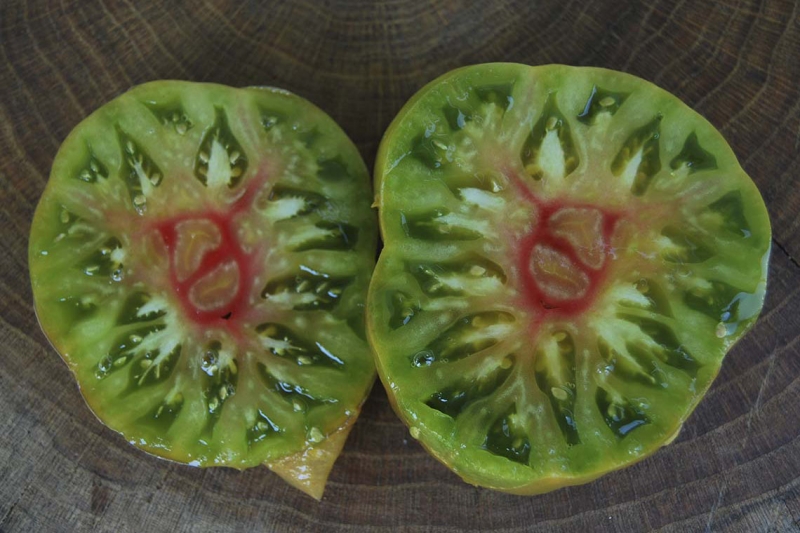
Gold:
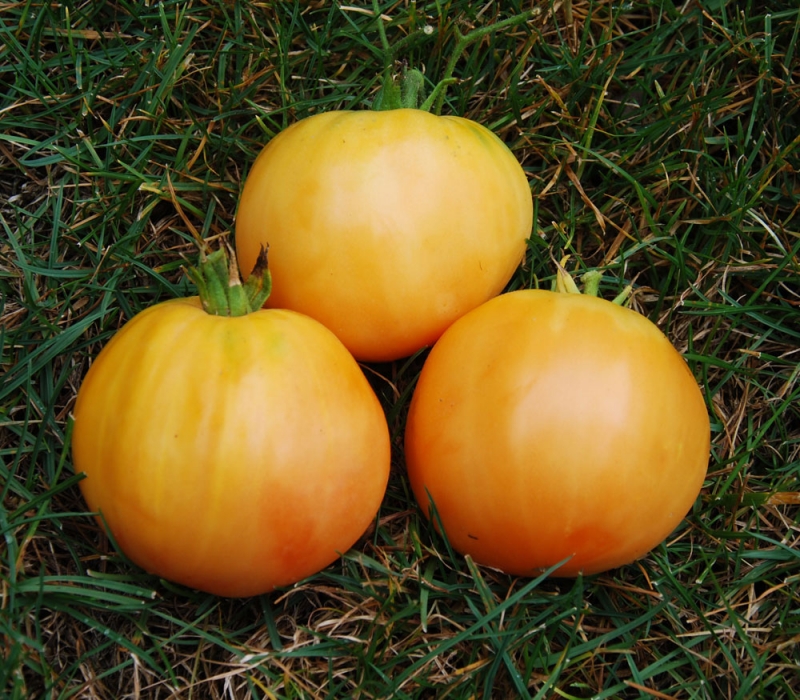
Steak:

Hawaiian:
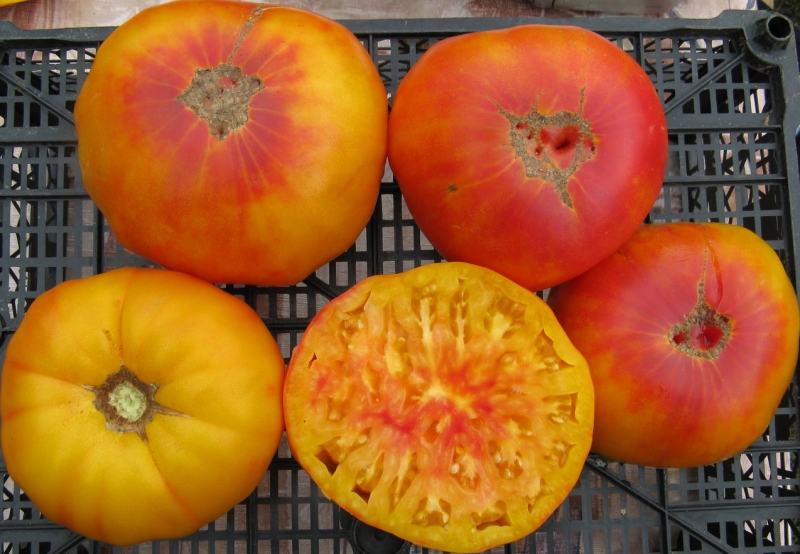
Farmers reviews
Reviews that farmers left after growing and eating tomato Pineapple:
- Victor, Taganrog: “A good variety that ripens earlier than others. Does not require special care, everything is according to the standard scheme, watering, feeding, etc. The only drawback is that the bushes need to be tied up, otherwise they break or fall. "
- Valeria, Volgograd: “I would recommend the Pineapple tomato variety to those who trade in vegetables or love to eat them. Vegetables grow well, do not get sick, but their high yield was not useful to our family, since we cannot eat much, and I do not use them for pickling because of their color. Therefore, one bag of seeds for one garden bed is enough for us. "
- Sergey, Ivanovo: “The variety is good, but those who have not planted it before will have to get used to the different taste. And so there are no more complaints. The yield is high, it bears fruit all summer, just have time to collect it. The main thing is not to forget to dive and tie up the bushes in time, as they grow very violently. If planted in a greenhouse, the bush can grow up to 2 m. "
Pineapple tomatoes - an unpretentious plantthat will not give you much trouble, positive in terms of cultivation, yield and consumption. It can be planted both in open ground and in a greenhouse. Bush formation and pinching are required.
Related Videos
We suggest watching a useful video about Pineapple tomatoes: